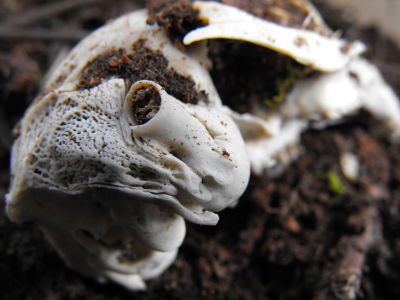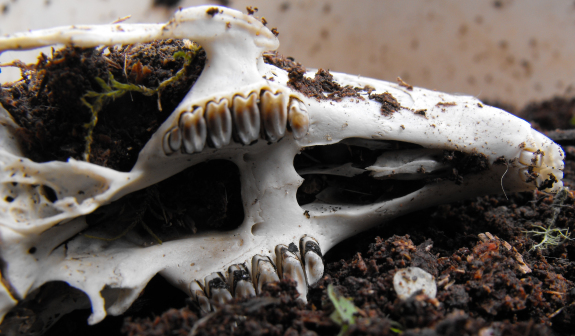
Skull identification
 While
digging around in the stump
dirt Thursday, I
uncovered some found art. Lucy must have buried a carcass in the
base of the stump because my scrabbling fingers turned up tufts of fur
and leg bones...and then this perfect skull.
While
digging around in the stump
dirt Thursday, I
uncovered some found art. Lucy must have buried a carcass in the
base of the stump because my scrabbling fingers turned up tufts of fur
and leg bones...and then this perfect skull.
I found a very useful key for
identifying mammal skulls and soon discovered the
skull's owner. The answer is after the second picture for those
who want to guess.

The first distinguishing
feature is the large gap between the majority of the teeth and the
incisors, which determines that the animal was either a rodent or a
rabbit. If you look closely below the big incisors at the front
of the jaw, you'll notice two smaller teeth tucked back into the
skull. These peg teeth are used for grabbing or cutting food and
identify my skull as a rabbit.
I find skulls endlessly
fascinating and once had a collection, but eventually learned that
collections bog me down. So I gave this rabbit to our winesap
apple tree as a source of
calcium.
Want more in-depth information? Browse through our books.
Or explore more posts by date or by subject.
About us: Anna Hess and Mark Hamilton spent over a decade living self-sufficiently in the mountains of Virginia before moving north to start over from scratch in the foothills of Ohio. They've experimented with permaculture, no-till gardening, trailersteading, home-based microbusinesses and much more, writing about their adventures in both blogs and books.
Want to be notified when new comments are posted on this page? Click on the RSS button after you add a comment to subscribe to the comment feed, or simply check the box beside "email replies to me" while writing your comment.
- Remove comment
- Remove comment
- Remove comment
- Remove comment

- Remove comment
- Remove comment
- Remove comment
- Remove comment
